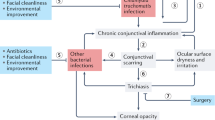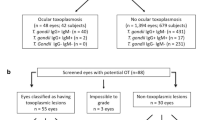Abstract
Purpose
To determine the prevalence of trachoma in the adult Chinese population.
Methods
The Beijing Eye Study as a population-based, cross-sectional cohort study included 4439 subjects out of 5324 subjects invited to participate with an age of 40+ years. Trachomatous abnormalities were assessed by slit lamp examination. Examination data were available for 4411 (99.4%) subjects.
Results
Trachomatous abnormalities were present in 850 eyes (mean±SE: 9.64±3.14%) or 422 subjects (9.57±0.44%), differentiated into follicular trachomatous inflammation (stage 1) (0.92±0.11%), intensive trachomatous inflammation (stage 2) (1.01±0.11%), trachomatous scarring (stage 3) (7.61±0.29%), and trachomatous trichiasis (stage 4) (0.47±0.08%). Trachomatous scarring was significantly associated with higher age (P<0.001), low level of education (P<0.001), rural versusurban region (P=0.04), and low visual acuity (P<0.001).
Conclusion
Active trachoma is present in about 2 out of 100 Chinese adults, and trachomatous scarring is present in about in about 8 out of 100 Chinese adults in Northern China with age, socioeconomic background, and rural region as main risk factors.
Similar content being viewed by others
Introduction
Trachoma is one of the leading causes for avoidable blindness worldwide.1, 2, 3, 4 Since recent population based studies on the prevalence of trachoma and its associations with demographic and ocular risk factors are scarce for the population of mainland China,5, 6 it was the purpose of the present study to assess the frequency of trachoma and its associations in Chinese adults living in Greater Beijing.
The Beijing Eye Study is a population-based cohort study in Northern China, carried out in four communities from the Haidian urban district in the Northern part of Central Beijing and in three communities from a rural district in the village area of Yufa (Daxing District) in the South of Beijing.7, 8 The Medical Ethics Committee of the Beijing Tongren Hospital had approved the study protocol and all participants had given informed consent, according to the Declaration of Helsinki. At the time of the survey in the year 2001, there were 5324 individuals aged 40 years or older residing in those seven communities. Home visits were performed according to a pre-study registration list, and the eligibility criteria for the study, an age of 40 or more years, was confirmed by door-to-door enrolment. The door-to-door visit was used to confirm the age of the subjects and to ask them a questionnaire including questions on their level of education and their family income. The level of education was differentiated into illiteracy, half illiteracy, visit of a primary school, middle school, or college. In total, 4439 individuals (2505 women) participated in the eye examination, corresponding to an overall response rate of 83.4%. Examination data for trachoma as obtained by slit lamp examination were available for 8822 eyes of 4411 (99.4%) subjects. Mean age was 56.1±10.5 years (range: 40–101 years), mean refractive error was −0.37±2.31 dioptres (range: −20.13 to +7.50 dioptres). The participants underwent an ophthalmic examination as described in detail previously.7, 8 It included measurement of visual acuity, visual field examination by frequency-doubling perimetry using the screening programme C-20-1 (Zeiss-Humphrey, Dublin, CA, USA), and pneumotonometry. Digital photographs of the cornea, optic disc, and fundus, and retro-illuminated photographs of the lens were taken. According to the classification of the World Health Organization (WHO),5 diagnostic criteria for trachoma were trachomatous inflammation characterized by five or more follicles, at least 0.5 mm in size, on the 'flat' surface of the upper tarsal conjunctiva (stage 1); intensive trachomatous inflammation characterized by inflammatory thickening of the upper tarsal conjunctiva with more than half of the normal deep tarsal vessels obscured (stage 2); trachomatous scarring with scarring of the tarsal conjunctiva (stage 3); trachomatous trichiasis with at least one eyelash rubbing on the eyeball or evidence of eyelash removal (stage 4); and corneal opacity when at least a part of the pupil was blurred or obscured (stage 5).
Trachomatous abnormalities were present in 850 (mean±SE: 9.64±3.14%) eyes. A follicular trachomatous inflammation (stage 1) was detected in 74 eyes (prevalence rate: 0.92±0.11%), an intensive trachomatous inflammation (stage 2) in 81 eyes (prevalence rate: 1.01±0.11%), trachomatous scarring (stage 3) in 657 eyes (prevalence rate: 7.61±0.29%), and trachomatous trichiasis (stage 4) in 38 (0.47±0.08%) eyes. In multivariate statistical analysis, presence of trachomatous scarring was significantly associated with higher age (P<0.001; 95% confidence intervals (CI): 1.08, 1.10), low level of education (P<0.001; 95% CI: 0.78, 0.92), rural versus urban region (P=0.04; 95% CI: 0.62, 0.99), and low best corrected visual acuity (P<0.001; 95% CI: 0.35, 0.69). Taking the presence of any trachomatous changes, multivariate analysis revealed a significant association with age (P<0.001; 95% CI: 1.06, 1.08), low level of education (P<0.001; 95% CI: 0.75, 0.88), rural versus urban region (P=0.04; 95% CI: 0.65, 0.99), best corrected visual acuity (P<0.001; 95% CI: 0.20, 0.42), and hyperopic refractive error (P<0.001; 95% CI: 1.03, 1.10). Defining blindness by using WHO criteria (visual acuity in the better seeing eye <20/400), revealed that two subjects with bilateral trachomatous changes were blind.
Active trachoma and trachomatous scarring are present in about 1 out of 10 Chinese adults in Northern China, with age, low socioeconomic background, and rural region as main risk factors, and decreased vision as consequence.
References
Ranson MK, Evans TG . The global burden of trachomatous visual impairment: I. Assessing prevalence. Int Ophthalmol 1995–1996; 19: 261–270.
Resnikoff S, Pascolini D, Etyàale D, Kocur I, Pararajasegaram R, Pokharel GP et al. Global data on visual impairment in the year 2002. Bull World Health Organ 2004; 82: 844–851.
Pascolini D, Mariotti SP, Pokharel GP, Pararajasegaram R, Etyàale D, Negrel AD et al. 2002 global update of available data on visual impairment: a compilation of population-based prevalence studies. Ophthalmic Epidemiol 2004; 11: 67–115.
West SK, Munoz B, Lynch M, Kayonoga A, Mmbaga BB, Taylor HR . Risk factors for constant, severe trachoma among preschool children in Kongwa, Tanzania. Am J Epidemiol 1996; 143: 73–78.
Liu H, Ou B, Paxton A, Zhao P, Xu J, Long D et al. Rapid assessment of trachoma in Hainan Province, China: validation of the new World Health Organization methodology. Ophthalmic Epidemiol 2002; 9: 97–104.
Boost M, Cho P . High incidence of trachoma in rural areas of Guangxi, China. Lancet Infect Dis 2005; 5: 735–736.
Xu L, Li J, Zheng Y, Cui T, Zhu J, Ma K et al. Intraocular pressure in Northern China in an urban and rural population. The Beijing Eye Study. Am J Ophthalmol 2005; 140: 913–919.
Wang Y, Xu L, Hu L, Wang Y, Yang H, Jonas JB . Frequency of optic disc hemorrhages in adult Chinese in rural and urban China. The Beijing Eye Study. Am J Ophthalmol 2006; 142: 241–246.
Acknowledgements
This study is supported by the National Key Laboratory Fund.
Author information
Authors and Affiliations
Corresponding authors
Additional information
Proprietary interest: none
Rights and permissions
About this article
Cite this article
Jie, Y., Xu, L., Ma, K. et al. Prevalence of trachoma in the adult Chinese population. The Beijing Eye Study. Eye 22, 790–791 (2008). https://doi.org/10.1038/sj.eye.6702857
Received:
Revised:
Accepted:
Published:
Issue Date:
DOI: https://doi.org/10.1038/sj.eye.6702857



